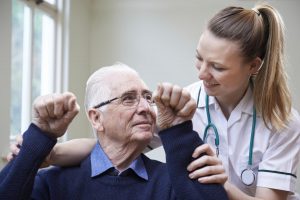
Here’s a Tip: A Good Exercise Program Can Slow Parkinson’s Progression
Before we get into Parkinson’s treatment… If you’ve been diagnosed with Parkinson’s and you want to do everything you can to slow its progression, here’s a tip. A good, active set of exercises that you do every day (or almost every day) can make Parkinson’s get worse more slowly. It only takes about 30 minutes a day to be effective. It seems that almost any type of exercise will do, as long as it’s “real” exercise. It’s often said, and it really is true, that the best exercise is the exercise that you’ll keep doing. So if you have Parkinson’s and you don’t exercise, find something you like doing to get you moving, and get started today.
There Are Many Good Medications for Parkinson’s Treatment
Here’s the good news, right up front. Parkinson’s research has continually found new medications for Parkinson’s treatment ever since the approval of Sinemet in the 1960s. In addition, new formulations of existing medications are continuously being made and are extremely helpful, making each medication dose last longer. These new formulations enable a person to take meds less frequently through each day. According to a recent report (10/12/2021) there are 64 drugs in development for Parkinson’s (and 85 for Alzheimer’s and 33 for multiple sclerosis). Beyond medications, there are other non-pharmaceutical treatments that come into play. (See our main page on Parkinson’s for a more general discussion.)
Parkinson’s Treatment – The Right Balance Does It
Treating Parkinson’s safely and effectively is all just a matter of medication balance, tracking disease progression, clinical effectiveness, and side effects. It’s a collaborative effort, patient and doctor working together, to pursue this balancing from the first day of treatment. Here’s why. It’s not just today’s medicine benefits and side effects. Having the right balance from the start can affect how long a person stays more well and less ill. Too much of a medication too soon in the course can allow disabling symptoms to come earlier in the progression of Parkinson’s. And, as anyone with Parkinson’s knows, it’s best for any disabling symptoms to start as far in the future as possible. But today also matters, that is, with too little medication Parkinson’s symptoms won’t change, and, of course, too much can overwhelm with side effects.
Understanding Parkinson’s Treatment is a Learning Process
As you might guess, there’s a whole educational process involved in a person learning to treat his or her own Parkinson’s. First to learn the medications, what each one does and how it works. Then to learn and put into practice how they control muscles, coordinated movements, and how they help with overall coordination and balance. This learning about the dose and timing is why new formulations of existing medications are so useful. Better formulations make the whole process easier.
A Reader Asks: Why aren’t there any drugs to cure Parkinson’s?
Sadly, this is a good question, because it’s true. There are no medications that change the deterioration of Parkinson’s in a meaningful way. There are no “disease-modifying” drugs for Parkinson’s. Here’s the problem. Both the muscle movement symptoms of Parkinson’s and the symptoms of other areas (emotions, thinking) happen because the nerves in those brain circuits stop working correctly and then die. We haven’t yet found a way to keep these dying nerve cells healthy and alive, and no way to grow new nerves to replace the ones that are gone.
The First Medication for Parkinson’s Treatment is Usually a Combination Tablet
The usual starting point in Parkinson’s disease treatment is a single tablet that is a combination of two medications, levodopa plus carbidopa. Most people find that this combination works the best at the start with the fewest side effects. This combo tablet and the effective way it works is often called the “gold standard” for treating Parkinson’s. Anything new would have to work better, or work at least as well with fewer side effects.
There Are Many Other Medications for Parkinson’s Treatment
After getting started with the levodopa/carbidopa tablet, there are several other medications that might be added as needed. To name a few, there are the “dopamine agonists”, pramipexole, ropinirole, rotigotine, and apomorphine, and the “anti-viral” amantadine. More on these later. Getting the medication dose right is part of the balance that needs to be achieved. Part of this exploration is working out which medications to take. It’s often the case that two or more medications are used together. You and your doctor will need to do a bit of trial and error to find the best ones for you, and the best fit might well change over time. The medications need to work well and also need to cause the fewest possible side effects. It’s all personalized medicine. There is no one best medication or mix of medicines that works for everyone throughout their course of Parkinson’s.
Finding Your Best Medications for Parkinson’s Treatment
You doctor tells you that, yes, you have Parkinson’s. Then the search for the best medications for you begins. Pramipexole and ropinirole are medications that might be used by themselves, at least early on. Later either one of them might be added to a mix of two or more medications if the Parkinson’s gets worse. Ropinirole or pramipexole might also be useful as an add-on medication to the levodopa if the levodopa starts to work less well. Or, if levodopa starts working better at some times and less well at other times.
Getting Control of Muscle Movements – The “Dopamine Agonists”
Pramipexole (Mirapex®) and ropinirole (Requip XL®) are two oral medications in the medicine family known as “dopamine agonists”. By themselves they don’t work as well as the carbidopa/levodopa combination for the muscle symptoms. But, they’re less likely to contribute to on again/off again medicine effects or movement side effects. They’re more likely to work by themselves early on, with early, mild Parkinson’s. But as the years roll by at some point the carbidopa/levodopa combination will work better. Even later, in more advanced Parkinson’s, one or the other might be added back in to help.
Other Formulations of the “Dopamine Agonists”
There’s a transdermal patch form of dopamine agonist medicine, rotigotine (Neupro®). There’s another dopamine agonist medicine that comes as a subcutaneous (under the skin) injection, apomorphine (Apokyn®). It’s useful as a rapidly-effective medication for quick treatment of “off episodes” during motor fluctuations. The apomorphine is also available as a sublingual film (Kynmobi®) but many people don’t tend to like it.
More Solutions to Parkinson’s Treatment
There are other medications that can be added only if needed to treat new situations as they come up. For example, the COMTs. The names of the COMTs are entacapone (Comtan®) and tolcapone (Tasmar®). They’re used as add-on medications if the benefit of levodopa seems to wear off too soon. (COMT stand for catechol-O-methyltransferase.)
Treating Tremor and Other Movement Problems
Amantadine was originally used to treat influenza, so became known as an antiviral drug. But it’s no longer used for influenza and it’s real value is in treating some symptoms of Parkinson’s. As with the dopamine agonists, amantadine might work by itself in early, mild Parkinson’s. In later Parkinson’s it can be added to treat some movement side effects from the levodopa. It’s often used to reduce the Parkinson’s tremor because the dopamine agonists don’t work on tremor. If it works it’s hard to predict how long amantadine will keep working, sometimes for months or years, sometimes only a few weeks. There are extended-release formulations of amantadine, like Osmolex ER® and Gocovri®. But these are more expensive than immediate-release amantadine and it’s unclear if they work any better.
Medications to Help in Specific Parkinson’s-Related Situations
Along the way in Parkinson’s treatment one begins to find that meds work less well, or work sometimes and not at other times. If during this part of treatment you suddenly are less able to be steady and smooth in your movements and less able to get things done, the MAOBs might help. Examples of MAOBs are rasagiline, safinamide, and selegiline. Sometimes, early on, a MAOB is added to your levodopa. (MAOB stands for monoamine oxidase B inhibitor.)
More Medications for Specific Situations in Parkinson’s Treatment
If a hand, arm, or leg starts to show a tremor-at-rest and the tremor is not helped by just levodopa, adding benztropine (Cogentin®) or trihexyphenidyl (Artane®) might help. (A tremor-at-rest is when you are resting the arm or leg, with no muscle tone, and there’s a tremor.) Neither of these two medications will help with your walking smoothly or other Parkinson’s symptoms. And, they only help the tremor that occurs when a hand, arm, or leg are at rest. These two meds aren’t used that much because they can make a person feel mildly confused.
Coping with Psychosis in Parkinson’s
People with Parkinson’s can have a change in their thinking, a confusion that comes over them. Parkinson’s is a brain disorder, after all, so it’s reasonable that the workings of the brain can be upset. Here we’re referring to brain changes that are called psychosis. Psychosis is when the new change is seeing, hearing, or believing what is not real, what is not true. When what the person thinks he actually sees or hears is really an illusion. It’s an hallucination. What the person believes is real is not real. It’s a delusion. What’s understood about a social situation is not correct. One thinks things are happening that are not really happening. Again, a delusion.
Psychosis in Parkinson’s is a Real Medical Challenge
This brain change that results in psychosis is a problem, and a big one. Psychosis in Parkinson’s disease presents a real medical conflict on what to do. The medications that are the best and that are always needed to treat psychosis push the opposite way of the medications used to treat Parkinson’s. Treating one makes the other one worse.
Pimavanserin (Nuplazid) for Psychosis in Parkinson’s
It feels like a medical miracle that such a medication as pimavanserin (Nuplazid®) was found. It’s the one medicine that works in a way that gets around the “opposite medication actions” problem. It makes the psychosis better but does not make the Parkinson’s worse. It’s so helpful in this situation that the FDA even approved it for Parkinson’s psychosis. It’s the first medication to get this approval.
Parkinson’s Can Become an Even More Complicated Condition
As someone lives with Parkinson’s for years and years more symptoms can appear. It seems that more and more keeps happening as time goes by, added to the symptoms that are already there. Fortunately, there is usually a medication that can help. Here are a few more things that can go wrong.
- Fatigue and sleepiness during the day
- Constipation
- Erectile dysfunction
Modafinil (Provigil®) might help with the daytime sleepiness and methylphenidate (Ritalin®) could be useful to treat the fatigue.
A type of laxative, the brand names Miralax® and Glycolax®, can usually help the constipation. These are called polyethylene glycol laxatives.
The usual medications, sildenafil (Viagra®), tadalafil (Cialis®), or vardenafil (Levitra®) can help men with erectile difficulties.
Deep Brain Stimulation Surgery for Parkinson’s
Yes, we know, it’s surgery. Surgery is not the first choice most people would want. But it might help. Deep Brain Stimulation surgery is a treatment for Parkinson’s that’s not a medication. It’s not a cure, just as none of the medications can cure Parkinson’s. Also, it does not slow the progression of Parkinson’s. And, it doesn’t help everyone. But, for some individuals who are not doing well with trying so many medications, it can be really useful. The benefits can last for up to 5 years. A successful surgery might stop really bad tremors, help with medication wearing off, and ease muscle movement side effects from the medications. One piece of good news is that it’s a surgery that doesn’t harm any brain tissue and the surgical changes can be reversed. If medications are not helping enough with Parkinson’s this surgery might be the next choice.
Helpful links:
Parkinson’s Clinical Studies – ClinicalTrials.gov
National Institute of Neurological Disease and Stroke – Parkinson’s Disease: Hope Through Research
National Institutes of Health PubMed Central – Current approaches to the treatment of Parkinson’s disease
Parkinson’s Foundation on Parkinson’s Treatment
The Michael J. Fox Foundation for Parkinson’s Research – Parkinson’s 101
The Mayo Clinic on Parkinson’s Disease
Over 260 Drugs in Development for Neurodegenerative Diseases
Drugs for Parkinson’s Disease. The Medical Letter on Drugs and Therapeutics, Vol. 63 Issue 1618, February 22, 2021.





